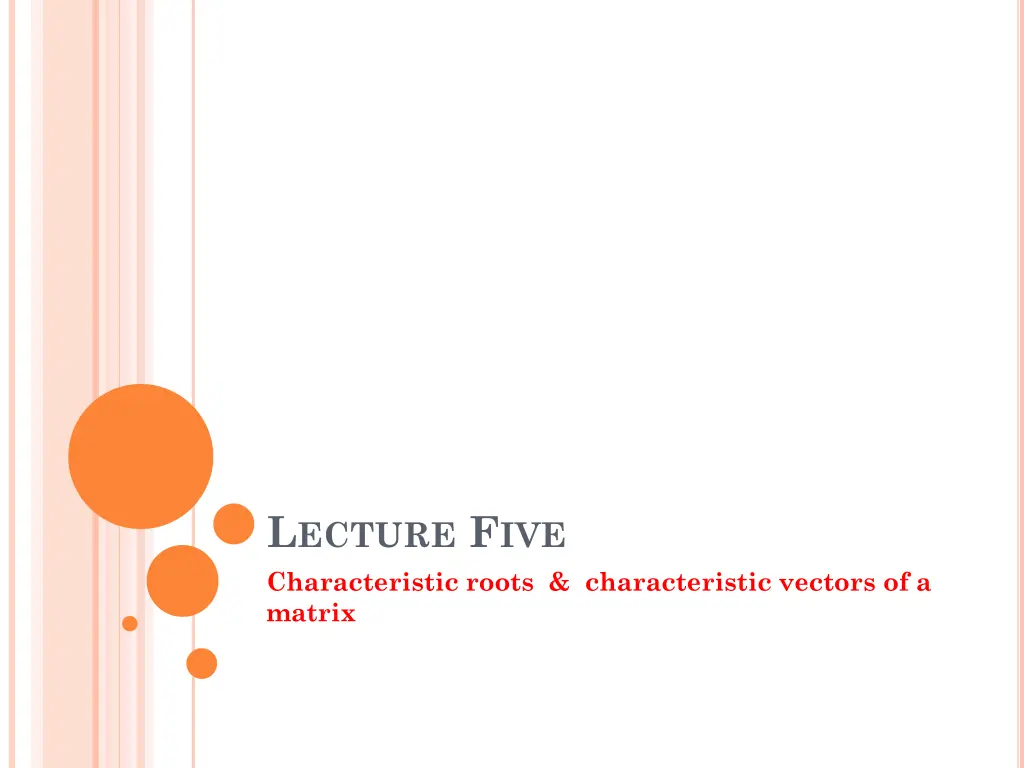
Understanding Characteristic Roots and Vectors of Matrices
Explore the concept of characteristic roots and vectors of matrices, including determining characteristic polynomials, properties of positive definite and symmetric matrices, orthogonal transformations, and reduction to weighted sum of squares. Learn about idempotent matrices, independent characteristic vectors, and orthogonal matrices. Enhance your understanding of quadratic forms and their matrix representations.
Download Presentation

Please find below an Image/Link to download the presentation.
The content on the website is provided AS IS for your information and personal use only. It may not be sold, licensed, or shared on other websites without obtaining consent from the author. If you encounter any issues during the download, it is possible that the publisher has removed the file from their server.
You are allowed to download the files provided on this website for personal or commercial use, subject to the condition that they are used lawfully. All files are the property of their respective owners.
The content on the website is provided AS IS for your information and personal use only. It may not be sold, licensed, or shared on other websites without obtaining consent from the author.
E N D
Presentation Transcript
LECTURE FIVE Characteristic roots & characteristic vectors of a matrix
The characteristic roots of the (pp) matrix A are the solutions of the following determinant equation: Laplace expansion is used to write the characteristic polynomial as: Since (Si) is the sum of all (i i) principal minor determinant, then:
Associated with every characteristic root (latent , eigen, proper) : iof the squre matrix A is a characteristic vector xi whose elements satisfy the homogeneous system of equations:
Properties of Characteristic Roots and Characteristic Vectors The characteristic roots of a positive definite symmetric matrix A are all positive ( i> 0), i.e.; there are p non-zero characteristic roots. The characteristic roots of a positive semi-definite symmetric matrix A are ( i 0), i.e.; p non-zero characteristic roots and (n-p) zero. For any positive definite characteristic roots of (A-1) are the reciprocal of characteristic roots of (A). If we have the matrix (Ak) , (k is a positive integer) then, it has the same characteristic vectors of (A) , i.e.; is the characteristic root of (Ak) , where is ( i) is the (ith) characteristic root of (A). symmetric matrix A, the
For every real symmetric matrix (A), there exists an orthogonal matrix (P) such that: where: D is the diagonal matrix of the characteristic roots of (A). The normalized characteristic vectors of (A) can be taken as the columns of (P) , such that: P'P=I. Any real quadratic form (Q.F.) can be reduced to a weighted sum of squares characteristic roots and vectors of its matrix, such that: x'Ax = y'P'APy transformation : x=Py where is: x'Ax = y'Dy = 1y12+ 2y22+ + ryr2 D = P'AP by computing the by using the orthogonal
Where is: i matrix. r The characteristic roots of an idempotent matrix (AA = A) are either zeros (0) or (1) ones and a quadratic form with such a matrix can be reduced to a sum of ( r ) squared terms. If (C) be the matrix whose columns are the (n) independent characteristic vectors of (A) then: B = C-1AC be the diagonal matrix with characteristic roots of (A). i.e. are the characteristic roots of the coefficient is the rank of the form. C: non-singular (full rank)
If i j for a symmetric matrix (A) , their corresponding vectors xi& xjare orthogonal. If (A) is orthogonal matrix , then all of its characteristic roots have absolute value of (1) i.e. If i> 0 , then x'Ax is positive definite and if then x'Ax is positive semi definite. The characteristic roots of (AB) are identical to the characteristic roots of (BA), i.e., as: tr(AB) = tr(BA). Furthermore; tr(BCA) ( 1). i 0 , r(AB) = r(BA) , as well tr(ABC) = Note: If the Q.F. is to be maximum then must be the greater characteristic root of A and x is associated vector. Similarly , if the Q.F. is to be minimum then must be the minimum characteristic root of A.






















